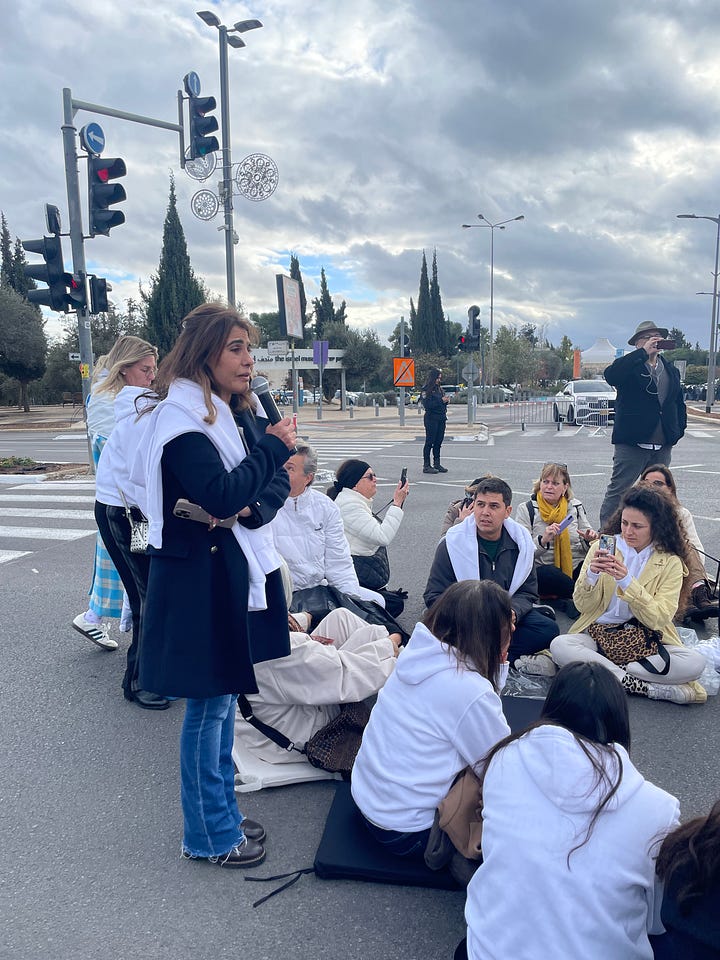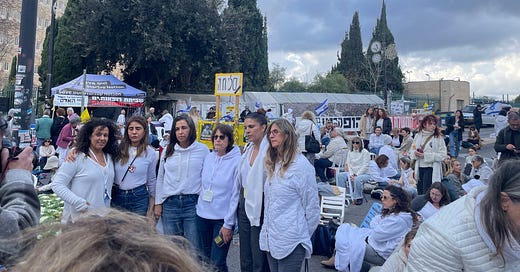It was Monday afternoon in Jerusalem, and the fourth week of Mishmeret 101, or Shift 101, the latest in the various protest movements for the hostages.
It’s a women’s movement, gathered around the hostage mothers and everyone wears white while sitting on the ground outside a government building, whether it’s the Knesset or Netanyahu’s Jerusalem house or the President’s Residence. They sit for several hours, quietly, sometimes softly singing, sometimes with one of the hostage mothers getting up to say a few words at the beginning or end or middle.
But the idea here is that they are out of words — and they each say that, nearly every time.
This movement was created by an Israeli professor who had studied Mahatma Gandhi’s nonviolent resistance that became a major tool in the Indian struggle against British imperialism.
He intended it for the hostage mothers, those whose daughters and sons are still held in Gaza, facing a long, cold winter in the Hamas tunnels.
Yesterday, I took a visiting friend and we headed to Kaplan Street outside the Knesset.
That’s where they intended to sit for the afternoon, according to a WhatsApp message I received from an organizer. But they weren’t there, and instead were sitting down the street, on the intersection just past the Knesset and the National Library, just before the Israel Museum, blocking traffic on Ruppin Boulevard, a pretty main thruway in Jerusalem.
Idan Alexander’s grandmother, Varda, was there. So was Yarden Gonen, sister of Romi Gonen, taken from the Nova. She sat in a circle with Ayelet Levy-Shachar, mother of Naama Levy, one of the surveillance soldiers taken on October 7, and Shira Albag, mother of Liri Albag, another surveillance soldier.
It was cold and windy and they sat and sat, the traffic moving around them, including an Egged bus that came within an inch of some of the women. Some sat on yoga mats or those fold-up chairs or a cushion snagged from a soccer game, most sat on the ground. Most of the women are middle-aged and older, with a few young moms with their kids in tow.


I was there as a reporter, but as always in this last year-plus, I’m there as a supporter, too, even though it’s complicated to be both.
I had gone to several of these gatherings last week, and one of the times I went, I wasn’t wearing white but a black fleece jacket. I figured I wasn’t going to be sitting with them, but speaking to people on the side, and sometimes you need that separation.
But I tend to second-guess yourself in these situations, because the hostage parents aren’t typical interview subjects. Yes, they’ve spoken with the media endless times over the last 14 months, the last 417 days, but most of them never interacted with the media in their former lives and now they’ve attained some kind of cult status — recognized and familiar and for all the wrong reasons. And now, all this time later, they rarely want to speak to the press.
As I crouched in my black fleece to speak to one mother, another woman tapped me and asked why I wasn’t wearing white.
Which made me think, maybe the moms are less likely to speak to me if I don’t look like them. Or maybe it doesn’t matter at all. And you know what? Impossible to know.
So on Monday, I had dressed in white — searching for all the warm winter white items in my closet, and pretty much wearing three layers of them on this cold day. (I find that at this age, I look better in white than I used to, maybe making up for those years when my mother wouldn’t let me wear white…).
I looked around at the moms, as I have on previous visits with this protest movement, and had one of those classic female thoughts, “Did they have these white tops a month ago? Did Niva Wenkert — one of the hostage mothers — go out and buy that fleecy white sweater specifically for this purpose?”
Hard to know, and I’m not about to ask, and I hope that one day I can chuckle with her about this minor detail of protests for her son, Omer Wenkert.
For now, though, she may talk about it with one of her friends who sits next to her on the ground, but probably not with me. Our conversations don’t extend that far.
It’s a well-organized event, like so many protests. This one has non-hostage family members organizing it, buying white hoodies to hand out if it’s cold, as well as white umbrellas for when it starts to drizzle or rain.
There’s a bluetooth speaker and microphone for the mothers to use, and a 30-minute session beforehand, near the Hebrew University Givat Ram campus, so that those attending can be instructed on what to do and where it’s happening.
I don’t know if it will make a difference in getting the 101 hostages home. For now, there are about 200 people each time, probably less yesterday, when it was cold and raw outside.
It made me think about something that I heard from
, author of “Shattered Tablets.” We met him last Shabbat and heard him speak on Saturday night. He spoke about how change can take place in a country, in unwieldy large nations like the US and small, tiny states like Israel.Israel, with its population of some nine million-plus, is small and agile, said Josh, and that’s in its favor when it comes to welcoming change and making it happen.
That’s why Shift 101 could grow to thousands, maybe, forcing the government to get the remaining hostages home. It’s why a new government could be elected, eventually, shifting us back to the democracy we were striving to be. Maybe. I’ll hold on to those maybes for now.




I cried.
Thanks Jessica for writing about Shift 101. They don't seem to be getting much coverage in the media (except for the Times of Israel).